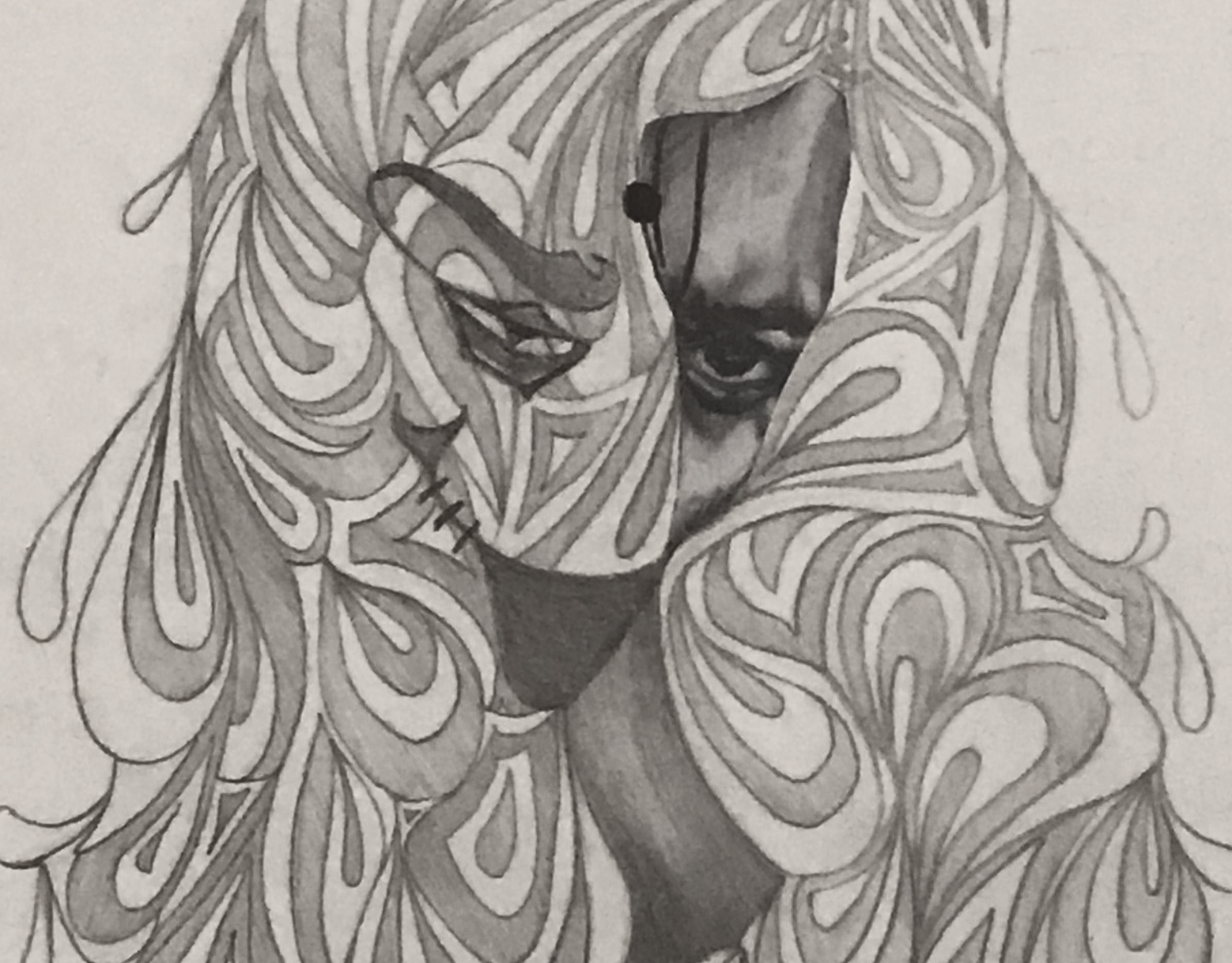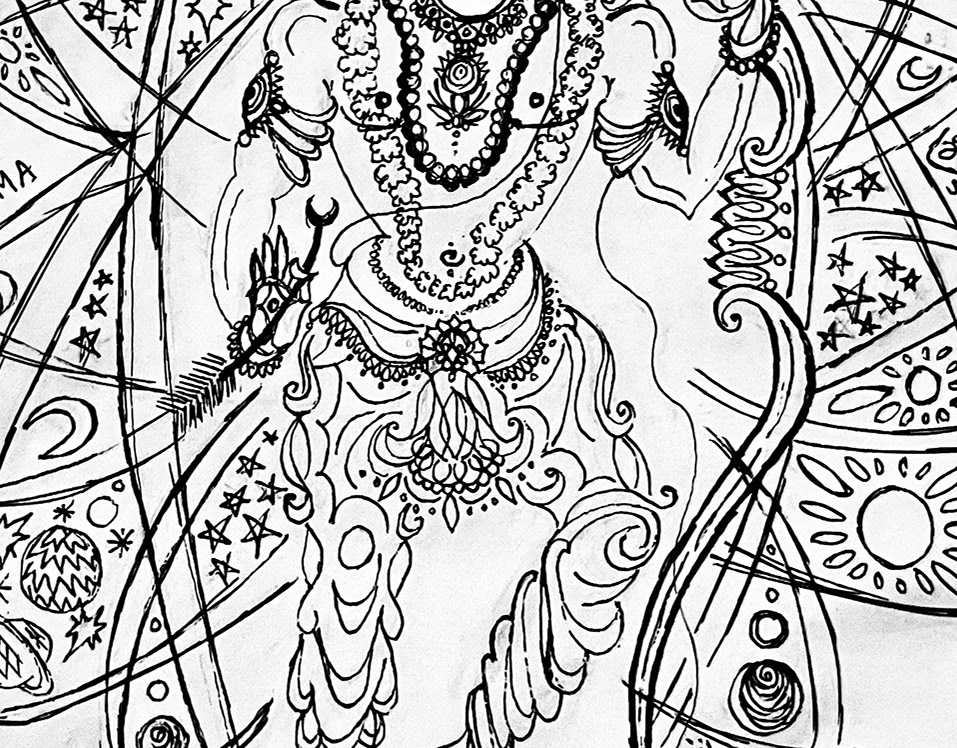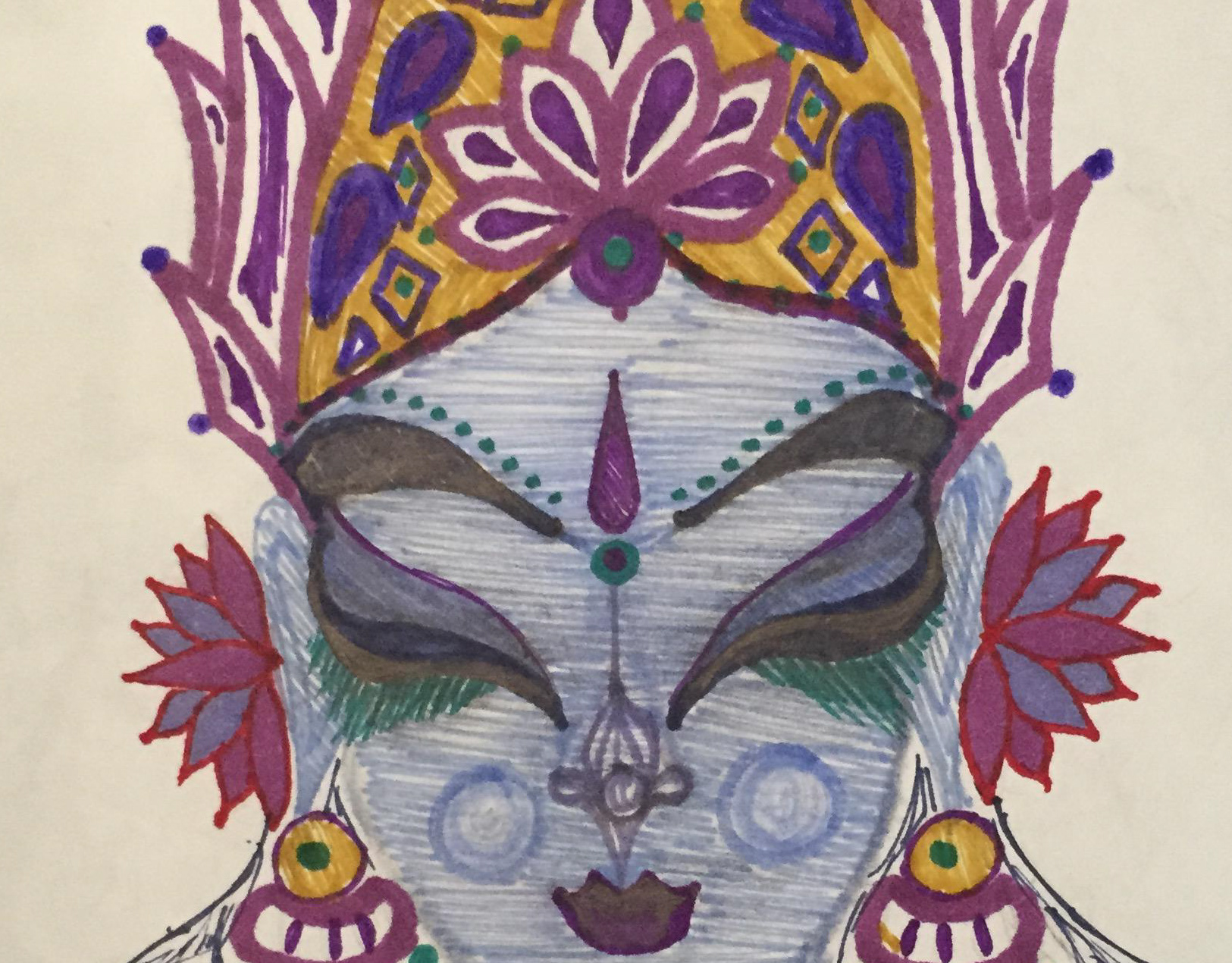"Sai Pallavi Portrait" (2022)
Freehand portrait of Telugu film actress, Sai Pallavi. Illustration, made with Adobe Illustrator, is of a close-up from "Shyam Singha Roy (2021)." Sai Pallavi portrays a devadasi, or hereditary practitioner of classical dance, who yearns to be with her beloved Shyam. This portrait aims to capture the character, so very young and yet so very old, gazing into the distance. Hence, her hair is partially black and partially implied to be white via frazzled strands and empty space. The medium is meant to mimic traditional ballpoint pen sketches while utilizing patchwork to create dimension and flow in facial features.
More from this Category:

"Self-Portrait in St. Petersburg" (2015)
Freehand pencil sketch using 4B and HB pencils. Drawn on a train from Moscow to St. Petersburg, with focus on blocks of unblended shadows and looser, flowing shapes. The goal was to blend realistic and surrealistic styles between face and hair. The linework outlining the profile purposefully thins and thickens to create delicacy.

"Untitled" (2016)
Drawn with ink and pencil. This sketch was intended to show the artist's style of interconnected shapes with a human face. Curves, sharp angles, and continuous lines dominate this piece. Thicker shapes mark the lips, brows, and eyes. The eyes themselves are intended to unsettle the viewer with their empty gaze. Pencil was used to fill in the lower lip, eyes, and outline the flower in the hair.

"Outer Animal, Inner Anguish" (2016)
Pencil drawing created for Drawing course. Displayed at Anglo-American School of Moscow. Realistic sliver of a face shows a tortured inner self, fighting for control inside the mind of a monstrous external self, shown with the cartoonish outer eye and stitched smile. A bindi/bottu holds both the external and internal self together, at the seams. The hair is drawn stylistically, with fluid shapes and slight curves fitted next to triangles.

“Ovarian Cancer Research Poster” (2020)
Designed for American Association of Cancer Research (AACR)'s Poster Session on Cancer Genomics, commissioned by Dr. Kavitha Advikolanu. Title: "Evaluation of genomic instability, ploidy status, and P53 expression in archival paraffin-embedded tissue from primary ovarian cancer specimens." Poster (including Schematic Summary flowchart, Immunohistochemical and Flow cytometry pie charts, bar graphs, scans, and tables) created using Microsoft Powerpoint, Excel. Organized with goal of organizing 12+ sections of the research paper into several flows via box alignments, along with laying out graphics and scans in equal proportion. Each section is condensed, taken from Dr. Advikolanu's research paper of the same title.

"Universe, Balance: Rama" (2023)
Created with ink, draft (scroll down) created with pencil. This illustration depeicts the Hindu god Sri Rama as the center of the universe, providing balance between opposing sides. He carries an arrow (with a crescent-shaped head, similar to that of ancient Indian arrows, which had different shapes) and bow whose string curls around his arms. His crown, belt, and jewelry indicate his status as a warrior king, and a sun-like halo surrounds his head. His forehead is covered in the symbol of the god Vishnu, whom he is the incarnation of. His pants are drawn stylistically to show draped silk. His feet have small sparks next to them. He is surrounded by a structure which contains suns and moons, planets and stars. Rama's name, in English, Telugu, and Hindi, is written amongst these parts of the universe. The structure symbolizes both the universe and an atom: to suggest that Rama is present in the largest scale and smallest scale. In this illustration, centering him within the smallest particle is a reference to Telugu poet Annamacharya's writing on the same subject. Finally, the sacred syllable "Om" outlines the structure. Note: This piece was intended to be the first in a series of illustrations for a devotional kirtan (song) about Rama, written by the late Dr. Advikolanu Muralidhar. So, this imagery reflects the lyrics. This style of art is inspired by the Vedic Art style, hence the curved body of the male figure, the oval-shaped face, and elaborate ornaments.

“Lakshmi: Serene Beauty” (2016)
Sketched with ink markers. Piece depicts the Hindu goddess of beauty and wealth, Lakshmi Devi. Two lotus flowers are tucked behind her ears, and her golden crown contrasts with the blue tone of her skin. Lakshmi is symbolically shown with blue skin to indicate that she is the wife of Sri Vishnu (who is also depicted with blue skin in Indian artwork to indicate that his skin is very dark, akin to that of blue rainclouds). Lakshmi's facial features in this peace are meant to bring a sense of peace, and her hair is drawn stylistically in curls.

"Portrait of a Russian Girl" (2016)
Drawn with pencil. The focus of this piece was to draw human eyes, brows, and a nose in accordance to correct proportions and realism. Note the shading, detail in the pupils, and how color is shown despite its absence.

"Tamilian Grandmother" (2014)
Freehand ink sketch of a South Indian Tamilian grandmother with two nose stud piercings. The style of her bottu/bindi is also associated with Tamil culture. For the sake of the sketch and in a break from the typical bottu/bindi, this design is repeated along the bridge of the nose. The eyes are slender and wing-shaped; the tinge of blue in them represents the onset of old age in a dark eyes. The hair is shown to be white and black, and bursting flowers are tucked behind both of the grandmother's ears. Her necklace is shown in the upper-right of the sketch. A hint of colored pencil was used to color the blue-green in her eyes and in her face. The lips are curved to indicate a hidden smile. This style is influenced by Bapu, a South Indian Telugu artist.

"The Suicide Pact" by Dr. Advikolanu Muralidhar (2021)
Book cover and jacket designed using Adobe Illustrator for "The Suicide Pact," an English play by Dr. Advikolanu Muralidhar, a South Indian Telugu poet and writer. The central lesson is highlighted on the back cover. Each element from the set design and the themes/events themselves are illustrated. The play centers on a professor and his artistic wife, Lalitha, who despise one another, themselves, and their lives. One night, they draft a suicide pact. Since the play occurs over one night, the book spine, and the book cover's ceiling fan contains a single moon. The ceiling fan, with a sari and tie hanging from it, implies potential death looming over the characters' heads. The eye in the fan represents the audience bearing witness, who ultimately decide the story's conclusion. One line from the fan spirals into two, connecting to "U" and "I" to symbolize individuals, once united in love, now estranged. The wall has several symbols: There are two portraits of a hanging, one with and one without the head attached, to show both potential conclusions to the story. There is Lalitha's scribble next to the hangings, as she laments the meaninglessness of art and art critique. A sketch of a mother and child is drawn by Lalitha yet slashed to show her lost dream of motherhood. A question mark and quotation marks show how the majority of the play is dialogue with existential questions. The quotation marks also hint at the professor's monologue about the pointlessness of speech. A cage from the set design provides a feeling of being trapped in marriage/life. Cigarettes, a watch, a fountain pen, bangles, an ashtray and the suicide pact itself, are laid out on a table. The mangalsutra (wedding necklace) lies discarded, to show the dissolvement of marital bonds. The professor's glasses are cracked, to show distorted perspectives. The table doubles as the Bombay apartment where the characters reside, with shattered windows on one side and windows with the words "You, Me" scribbled on in Telugu. "You, me" is a phrase repeated when the characters are in love, yet those words change their meaning that night. The last letter of "Me" and the first letter of "You" are the same in Telugu, hence they merge initially (to symbolize unity in love) and gradually separate and reflect (to symbolize distortion of the self and separation in marriage) on the apartment and on the back cover's lower border.

"Chitrakootha Forest Romance" (2023)
Drawn with ink. Figure on the left is a Hindu goddess, Sita Devi, daughter of the earth. Figure on the right is Sri Rama, the Hindu god of the epic "Ramayana." Here, in the Chitrakootha forest, we see Sita playfully stealing Rama's quiver of arrows and twirling one arrow out of Rama's grasp. Rama holds Sita's waist and shoulders his bow. Intricate linework shows the movement of the arrow, leaves and flowers stitched into Sita's skirt, jewelry, and crown, and lotus flowers in Rama's pants. He wears a thread and prayer beads around his body, and the fabric tied around his waist shows his sweeping movement towards Sita. The marks of divinity are on Sita and Rama's foreheads; they are surrounded with halos and hearts. Thicker lines outline key features of their bodies, and their hair is elaborately styled. The thin, simple bowstring is meant to contrast with the details of their garments. Their feet and faces are drawn stylistically, to show loving gazes and surreal beauty.